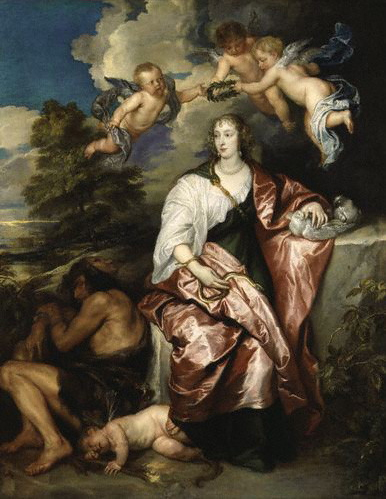A lot of the paintings in ''The Swagger Portrait'', at the Tate Gallery, have the character of dim and distant relics, the products of a world almost inconceivably alien to our own. Take Van Dyck's Venetia Stanley, Lady Digby, as Prudence, whose iconography is so complex that the sitter seems to be juggling with her attributes like some kind of 17th-century plate-spinner: she consents to be crowned by three fluttering putti while simultaneously fondling a pair of doves with one hand, holding a serpent in the other, trampling a torch-bearing Cupid underfoot and studiously ignoring the figure of Janus who skulks behind her.
All becomes clear when you know that this is the portrait as retrospective self-justification: it was commissioned by Lady Digby's husband to put down rumours that she had had an affair with the third Earl of Dorset. What Van Dyck painted was the Victory (laurel wreath) of Lady Digby's Chastity (doves) and Wisdom (serpent) over the forces of Lust (Cupid) and Deceit (Janus).
Not that any of this makes the picture seem that much more approachable to modern eyes. It is a little hard, really, to imagine a modern equivalent. David Mellor as Fidelity Triumphant? , maybe (''the sitter, portrayed in a rocky landscape, is accompanied by his dog, symbol of constancy. The significance of the discarded clothing with which the landscape is strewn, which has been identified as the strip of Chelsea Football Club, has no iconographical precedent and has baffled most commentators . . .'') It would never happen. These days, not many people who want to justify or reinvent themselves hire painters. They hire ghost-writers and try to sell their Exclusive Stories to The Sun.
One of the traditional fascinations of portrait painting is the illusion it gives of contact with...

Posture and imposture
20-10-1992

